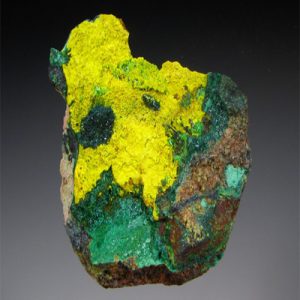Vandenbrandeite
Vandendrandeite is a copper uranyl hydroxide mineral that is very strongly radioactive. It contains over 59% Uranium (U). The picture above shows green micro crystals of Vandenbrandeite in yellow Soddyite another Uranium rich mineral. Vandenbrandeite is often closely associated with other radioactive minerals such as Cuprosklodowskite, Curite, Kasolite, Sklodowskite, Swamboite, Torbernite and Uranophane.
Vandenbrandeite was named by Alfred Schoep in 1932 in honor of Pierre Van den Brande (1896-1957), Belgian geologist, Geological Survey of Katanga, who discovered the deposit at Kalongwe deposit, Katanga, Democratic Republic of Congo (Zaïre).
As with all radioactive minerals always wash hands after handling. Avoid inhaling dust when handling or breaking. Never lick or ingest. Avoid prolonged exposure in proximity of the body. Store away from inhabited areas.
Locations for Vandendrandeite: In Congo (Zaire), in Katanga (Shaba) Province, from the Luiswishi mine; at Kalongwe; from Shinkolobwe; at Kambove; from Swambo; and in the Musonoi mine, near Kolwezi. In the Rabéjac uranium deposit, seven km south-southeast of Lodève, Hérault, France.
| Chemical Formula: | Cu(UO2)(OH)4 |
| Copper Uranyl Oxide Hydroxide | |
| Molecular Weight: | 401.60 gm |
| Composition: | Uranium | 59.27 % | U | 67.24 % | UO2 |
| Copper | 15.82 % | Cu | 19.81 % | Cu2O | |
| Hydrogen | 1.00 % | H | 8.97 % | H2O | |
| Oxygen | 23.90 % | O | |||
| 100.00 % | 96.02 % | = TOTAL OXIDE |
| Crystallography: | Triclinic – Pinacoidal |
| Crystal Habit: | Crystals, flattened on {001}, may be lathlike, rounded, to 0.5 cm; in parallel aggregates, lamellar, scaly; massive |
| Twinning: | None |
| Cleavage: | Perfect on {110}; distinct in the [001] zone; and also indistinct in that zone |
| Fracture: | n /a |
| Tenacity: | Brittle |
| Moh’s Hardness: | 4.0 |
| Density: | 4.91 – 5.03 (g/cm3) |
| Luminescence: | None |
| Radioactivity: | Very Strong; GRapi = 4,352,567.33 (Gamma Ray American Petroleum Institute Units) |
| Health Warning: | Contains Uranium – always wash hands after handling. Avoid inhaling dust when handling or breaking. Never lick or ingest. Avoid prolonged exposure in proximity of the body. Store away from inhabited areas. |
| Color: | Dark green to nearly black; green in transmitted light |
| Transparency: | Translucent, transparent in thin fragments |
| Luster: | Vitreous |
| Refractive Index: | 1.765 – 1.800 Biaxial ( + ) or ( – ) |
| Birefringence: | 0.035 |
| Dispersion: | Visible to strong |
| Pleochroism: | X = blue-green, Z = yellow-green |


